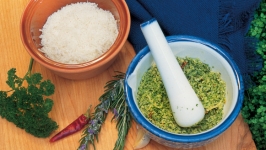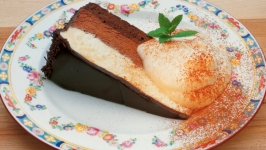Garden to Table : Start with Herbs
![]() Growing up, I was an “herb illiterate.” All I knew was that, in our house, dill was a flavor in pickles, sage was added to turkey stuffing and parsley was put on the side of a plate and you never ate it. Today, as my grandmother would say, “I grow an elegant sufficiency” of herbs, most of them in containers conveniently on my front patio. I seldom need to buy them, and I can have herbs that aren’t available in most food markets.
Growing up, I was an “herb illiterate.” All I knew was that, in our house, dill was a flavor in pickles, sage was added to turkey stuffing and parsley was put on the side of a plate and you never ate it. Today, as my grandmother would say, “I grow an elegant sufficiency” of herbs, most of them in containers conveniently on my front patio. I seldom need to buy them, and I can have herbs that aren’t available in most food markets.
With a symphony of flavors at my fingertips, I just harvest a few sprigs of sage or thyme to kick up the flavor of roasted vegetables, or I can snip a few leaves of chives for egg salad, or add cilantro to a spicy wrap on a whim—much of the year they are all but a few feet away.
Years ago I started growing herbs for their culinary uses but as the time went on I realized that they’re integral to a healthy lifestyle. I’ve even been asked by a few doctors around the country to design mini herb gardens outside their offices so their dietitians can instruct patients on healthier ways to eat.
Why are health professionals enthusiastic about herbs? First, most of the culinary herbs are very high in antioxidants—those ingredients in food that are thought to boost our immune system, prevent damage from environmental toxins and mitigate against some of the effects of aging. Most research indicates they are more effective when taken in food than in supplements.
Popular herbs like oregano, rosemary, basil, thyme and cumin are antioxidant-rich. The ubiquitous parsley, probably the most popular and nutritious herb in the world, is not only high in antioxidants, it is also very high in vitamins C and A, folic acid and iron. But that’s just one aspect of herbs’ healthy side.
For those of us who try to limit meat in our diet, herbs can add needed flavor to our meals. I like to substitute herbs for the pepperoni on a pizza, adding a few anise seeds to the sauce and placing chopped parsley and oregano under the cheese. Just before serving I sprinkle on generous amount of fresh chopped basil. In a similar vein, herbs are perfect for folks cutting down on salt.
A small patch of fresh herbs can definitely up your game when you entertain. With your herb garden you can create authentic ethnic recipes using herbs you can’t find in stores, through simple additions such as sweet woodruff to a traditional German May Wine, Thai basil and lemon grass to your curry and the delicate chervil to a classic French mesclun salad.
I learned when working with chefs additional uses: employing the sturdy stems of tall rosemary as flavorful skewers for kabobs, frying fresh sage leaves for a crunchy topping for a squash or floating a blue borage flower atop a glass of sparkling water or white wine.
Another advantage of herbs is that they can be a lovely addition to your landscape. Imagine the silvery foliage and fragrant flowers of lavender and the large yellow sprays of fennel flowers as stars in your ornamental border. Picture a green fragrant carpet of sweet woodruff along your shady woodland path, or even a clipped rosemary topiary next to your front porch.
Further, if given the correct climate and exposure, since they are such healthy growers they usually look their best all season long. Most herbs have few pests and, with good drainage, few diseases. As a bonus, most are drought tolerant. The perennials such as sage, thyme, fennel and oregano only require cutting back in spring (as a bonus, use the trimmings in the coals when you are grilling).
In fact, I recommend herbs to my novice landscaping clients, as I consider them edible plants with training wheels.
I’d like to end my homage by pointing out that herbs are a big plus for the environment. Their small flowers, which are preferred by most beneficial insects, including our threatened bees, provide a long season of pollen. Plus that most super of herbs, parsley, and its relatives dill and fennel also provide food for the black swallowtail larvae.
Clearly I can’t praise herbs enough!
A Taste of Winter Herbs
From your gardens in the Bay Area, you can enjoy a host of winter herbs including sage, winter savory, thyme, oregano, mint, lemon balm and marjoram. Keep a few perennial herbs like rosemary in sunny-side pots or artfully grown near your kitchen entrance for a quick snip and a flavorful pop to any dish.
Rosalind Creasy shares a few recipes from her new book, The Kitchen Herb Garden: Growing and Preparing Essential Herbs, featuring winter herbs that grow easily in local gardens.
Winter Herbs Recipes
Try out thiese quick-and-easy recipes for a wintry Rosemary Pesto sauce, or this festive recipe for Mint Whipped Cream from the book The Kitchen Herb Garden.




